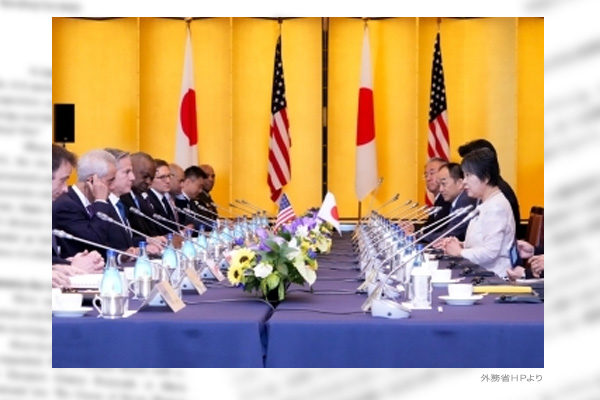A Japan-U.S. ministerial meeting on extended deterrence took place in Tokyo on July 28. This was the first political-level meeting on U.S. extended deterrence including nuclear deterrence, coming after working-level dialogues over more than 10 years.
“The Ministers reaffirmed both countries’ commitment to close consultations on U.S. nuclear policy and posture, as well as relationship between nuclear and non-nuclear military matters within the Alliance,” said a joint statement issued after the meeting between Japanese foreign and defense ministers and U.S. secretaries of state and defense. “They reaffirmed their intent to continue discussions on both countries’ deterrence capabilities and measures.”
Amid concerns about the possibility of Russia’s use of tactical nuclear weapons in Ukraine, the danger of potential nuclear intimidation and attacks by China has been discussed on the Far East front. The joint statement issuance at such time is recognized as a timely, important step.
Enhancing relationship with U.S. nuclear forces
Of particular importance was the confirmation of “close consultations on […] relationship between nuclear and non-nuclear military matters within the alliance.” In the current situation where it is difficult for Japan to possess its own nuclear weapons for deterrence, Japan’s efforts to strengthen deterrence to the maximum extent possible with conventional weapons, while entrusting strategic nuclear deterrence to the U.S., will enhance the relationship between the U.S. nuclear forces and Japan’s non-nuclear forces.
For instance, if China attempts to use its tactical nuclear weapons against Japan under the situation where U.S. and Chinese strategic nuclear forces are almost balanced in the near future, it will be extremely important for Japan to have its own capabilities to deter such attacks. Specifically, the idea is for Japan to use its non-nuclear forces to counterstrike command and control facilities, tactical nuclear missile launching sites, and other military targets indispensable for China’s tactical nuclear attacks. Possible counterstrike weapons include longer-range versions of standoff missiles and hypersonic glide vehicles now under development.
The U.S. for its part will deter China at the strategic nuclear level, provide Japan with military intelligence for Japan’s counterstrikes, and carry out non-nuclear strikes against military targets beyond the reach of Japanese forces. In this way, Japan and the U.S. will jointly deter Chinese tactical nuclear attacks. This represents Japan’s unique policy to deter nuclear attacks with conventional forces while preventing escalation to a nuclear war.
Expecting specific discussions
“We reaffirm the critical importance of continuing to enhance U.S. extended deterrence, bolstered by Japan’s defense capabilities,” said the U.S.-Japan joint leaders’ statement on April 10. There is a real need to work out in detail how the deterrence, enhanced by Japanese standoff missiles and hypersonic glide vehicles, can be built up as a joint US-Japan nuclear deterrence. With the goal of no more nuclear attacks on Japan, I expect more in-depth discussions will be held in the days ahead.
Kiyofumi Iwata is a member of the Planning Committee at the Japan Institute for National Fundamentals. Formerly, he served as Chief of Staff of the Japan Ground Self-Defense Force.


